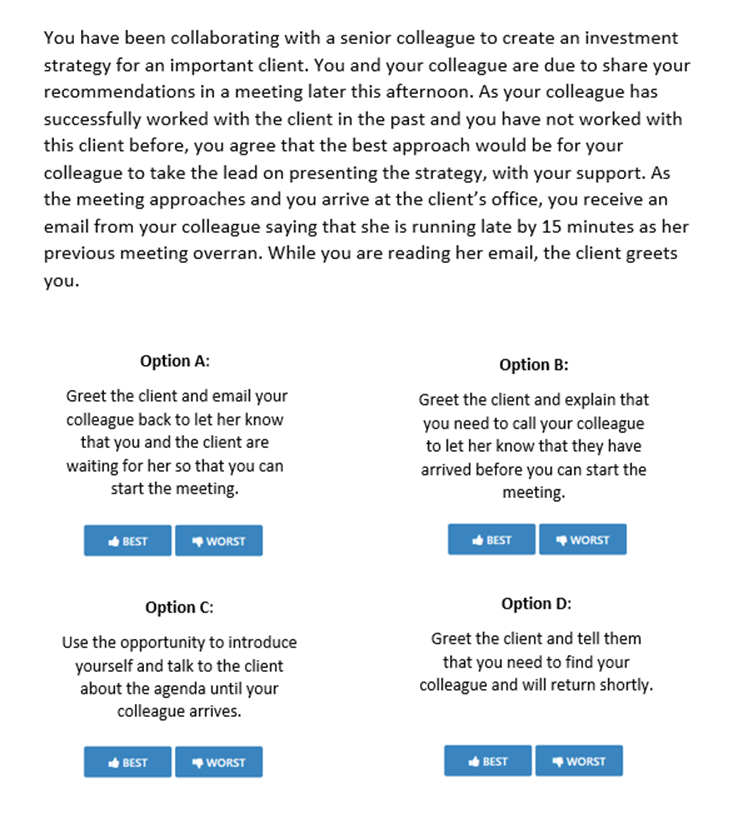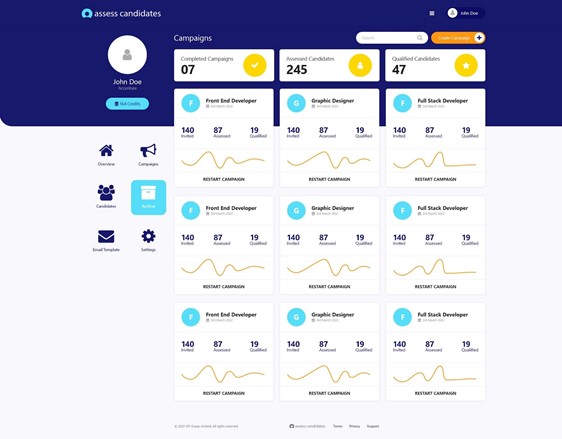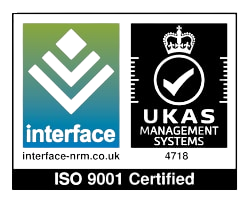Situational Judgement pre-employment tests for recruitment
Are you assessing candidates’ suitability, in terms of both drive and core knowledge? Are you a talent acquisition specialist, maybe an experienced recruiter, HR expert or a hiring manager? Most probably you are already using some assessment tools to help you find and hire the best fit candidate, fast. These tools may include aptitude tests, video interviews, assessment centres or even game-based assessments.
If you are looking for answers to questions such as
- What is a pre-employment situational judgement assessment test (SJT)?
- How can situational judgement tests be used in my company hiring process?
- How can situational judgement tests help me find the best candidates?Why use situational judgement pre-employment tests in hiring
- When should situational judgement tests be used in recruitment?
- Which roles are best suited for using situational judgement tests?
- What are advantages and disadvantages of using situational judgement tests?
Keep reading to find out how to use situational judgement tests to select candidates and recruit best fit talent.
This article will provide you with an informative, easy to read summary about one of the most widely used competency tests used in recruitment and candidate selection – pre-employment situational judgement test.
As a recruiter, you need to have a portfolio of tools that helps you select the best candidates, fast and without spending thousands of dollars, pounds, or euros.
Designing a properly functioning recruitment funnel helps a lot. The hiring funnel is the series of stages through which a candidate’s consideration for employment progresses.
This article unveils key aspects of the situational judgement tests and their use in hiring. You will learn what situational judgement tests are, pros and cons of using them, which roles would benefit the most from their use and why they are so popular.
Keep reading to find out more and if you have any questions, just contact us. With many years of experience, we, Assess Candidates, are a team of organisational psychologists and consultants who are here to help you set up the candidate assessment process and tests to recruit the best candidates for your organisation.
Contents:
- What is a pre-employment situational judgement test (SJT)?
- How are situational judgement tests used in recruitment?
- What skills can be assessed when using situational judgement tests?
- Example of a situational judgement test question
- Advantages and disadvantages of using situational judgement tests? Pros and Cons
- What roles should situational judgement be used to recruit for and why?
- When should the situational judgement test be used to recruit?
- Which organisations should use situational judgement tests in hiring?
- Why are situational judgement tests so popular?
- Why use Assess Candidates situational judgement tests to hire?
1. What is a pre-employment situational judgement test (SJT)?
Pre employment situational judgement tests are one of many psychometric tests commonly used in recruitment. They assess a person’s ability (competence) to choose the most appropriate action in a workplace situation based on a series of scenarios provided. Typically these tests can be job / competence specific (e.g. you may assess a candidate for a sales job using specific competencies required in sales).
Situational judgement tests can be standardised or produced on a bespoke basis for your organisation, and actual examples from the job role are used. As a result, these tests carry high face validity and individuals taking these assessments are likely to see the relevance of the test to the job they are being assessed for. They tend to be favoured by candidates as they get a feel for the job and deeper insight into the role.
Most often the interim solution is provided, i.e. a recruiter provides key criteria for a job (e.g. competencies) and the SJT is built from a bank of questions for that specific role considering the abilities sought after and to be tested.
If you need a test that informs you on whether a candidate’s behaviour fits with what is expected in your organisation, then the situational judgement test is right for your company.
Assess Candidates’ Situational Judgement Tests have been prepared by experts with many years of experience with top test developers (such as SHL and Kenexa) and are easily self-customizable for dozens of roles. Our team will give you all the help you may need to set up your bespoke SJTs if needed.
Situational judgement assessment tests are:
- widely used in recruitment by thousands of companies to sift candidates during the recruitment process through measuring a candidate’s:
- behaviour in certain situations
- behavioural tendencies
- response to real situations and challenges
- effectiveness of judgement
- used in recruitment at any level of hiring, from entry level to senior jobs.
- usually set out as a series of best and worst statements. The SJT test provides scenarios from which candidates have 4 choices of action. Applicants are required to choose the ‘best’ and ‘worst’ option. The other two options lie somewhere in between.
- Not typically timed, they are designed to test a candidate’s insights into practical answers. The prime reason of the test is not to be quick but for the candidates to be able to identify the competency required within the question. Nevertheless, a typical test of 18 questions is likely to last around 30 minutes.
- can be used to test a different range of targeted skills, for example, some questions may target a candidate’s ability to show leadership, whereas another may identify organisation.
For recruiters and hiring managers, situational judgement tests form a fundamental part of the selection process supporting in finding those applicants that have the competence to fill the requirements of the role.
Keep reading to find out more about how you and your organisation can benefit from using pre-employment situational judgement tests.

2. How are situational judgement tests used in recruitment?
In situational judgement tests, candidates are presented with a passage and asked to choose two answers out of 4, which is the best and which is the worst. As such, situational judgement tests allow a candidate to demonstrate their understanding of the best courses of action required per role relating to many different competencies. With a lenient time limit, candidates are not challenged by the clock, the focus is on their ability to cope with various realistic situations.
Situational judgement recruitment tests:
- Help employers be capable of more accurately predicting a candidate’s performance before their first day on the job.
- Situational judgement tests have been used for several years and they are increasingly becoming more popular. Especially with the move to online learning and assessing, situational judgement tests have become a staple tool for dozens of thousands of employers globally.
- Are most likely to be used at an early stage in the recruitment process.
- Typically following the sifting of job applications and the screening process. By inviting every candidate to take a situational judgement test, you can discount those who don’t meet a certain standard.
- Can be used by employers to assess candidates for all levels
- These roles can include finance, public professions, and retail, from entry level to senior positions. Typically different questions (situations will be used for different seniority levels).
Let us now see how this process could work in your organisation.
- It first starts with the candidate filling in the application and uploading a CV.
- The second stage is likely to be a situational judgement test, numerical reasoning test or another type of aptitude test. Assessing a candidate with these tests all together assesses their numerical/verbal ability as well as their competencies.
- Alternatively, if that does not work for you, you can assess candidates with the numerical and verbal test and then after this, the SJT can be given to those who meet a given threshold.
- Recruiters then go through the process of selecting candidates for the next recruitment stages and typically move on to further psychometric testing, usually a personality test, or game-based assessments.
- This is then followed by assessment centres and video/in-person interviews
When a recruiter or a human resources specialist invites pre-screened candidates to online situational judgement tests, the candidates have a dedicated period (usually several days) to complete the tests at home. The recruiter then reviews the results via an online report and selects the candidates to move to another round of the assessments.
There are a handful of companies on the market providing situational judgement tests solutions. Often, you may need to explore if a bespoke solution will be appropriate and cost-effective.
Off-the-shelf situational judgement tests will usually do the job. However, if you want a more personalised specific test related to your advertised role and company competency framework, this is also possible. Make sure they can prove that their tests have been created and validated by professional organisational psychologists and psychometricians. Otherwise, these tests will not deliver on selecting the right candidates.
Important. Often situational tests are used in conjunction with other psychometric tests so the decision to qualify a candidate to the next round may be based on combined results as well as on the type of role. If you would like to get a better understanding of how to use situational (and other) reasoning assessments, please contact us for free advice.

3. What skills can be assessed when using situational judgement tests?
Situational judgement tests can help assess the skills and select candidates who possess critical skills necessary in today’s virtually remote world.
Recruiters often use SJT’s to assess a candidate’s ability to:
- Understand how they might respond to real situations and challenges in the job
- Identify the effectiveness of their judgement
- Give them an insight into the situation and demands they might face in the job
Situational judgement tests are usually used to assess a candidate’s ability to embody a specific competency.
Typically, there are many competencies which are amenable to all SJT’s, here are some examples:
- Leadership
- Resilience
- Planning
- Organising
- Communicating
- Influencing
- Decision-making
- Remote working
The results of the situational judgement test will demonstrate an individual’s ability in different competencies and their strengths and areas for improvement. For example, if applying for a consultant role, the skills that a candidate must acquire are analytical skills, excellent interpersonal skills and teamworking skills.
Situational judgement tests help candidates to be aware of making important decisions in the workplace, identify different competencies needed and set achievable goals.
Further in the text you will find specific roles where the use of pre-employment situational tests in the job interview process is highly recommended.

4. Example of a situational judgement test question for selection
To help you visualise the SJT questions used in candidate selection, here is an example of a pre-employment situational judgement test question with worked solutions:
Pre-Employment Situational Judgement Test Question Example

The task:
- Candidates are presented with work-specific situations and asked to judge how they would respond to a potential work dilemma.
- The SJT test provides scenarios from which respondents have 4 choices of action. They are required to choose the ‘best’ and ‘worst’ options.
Note: the other two options are somewhere between the best and worst.
There is not usually a specific time limit per question. However, in our tests at Assess Candidates we provide an hour for the applicants to complete the test to ensure they submit all 18 questions.
Situational judgement recruitment test example worked solution:
- C is the best course of action. A candidate’s ability to show initiative is a key trait sought by many recruiters across a range of industries. The other three options involve asking others for their assistance and shifting additional work on to them. This option sees the candidate taking individual action to get this matter resolved as soon as possible.
- D is the worst course of action. It implies to the client that the candidate is uncomfortable in taking the lead and introducing themselves.
The question above is an example of a candidate being assessed for a finance or a sales role.
5. Why use situational judgement pre-employment tests in hiring? Pros and cons.
Advantages and disadvantages of using situational judgement tests in candidate selection
Why should you consider using situational judgement tests in hiring?
7 REASONS (PROS) TO USE SITUATIONAL JUDGEMENT ASSESSMENTS IN RECRUITMENT
- Highly job relevant – situational judgement tests have relatively strong research support in terms of validity and due to each specific question being linked with a competency it means it is highly relevant to the specific role.
- Efficient, low cost per candidate – situational judgement tests are distributed and completed online, so no paper, printing, or postage fees. They are typically priced per test (candidate) or using a flat fee for a maximum number of tests used. This approach helps to minimise the costs for volume recruitment and enable testing of thousands of candidates at low fees.
- Speed – thousands of candidates can be tested in a matter of days and the results are available immediately after test completion. It is very easy and fast to select candidates that meet a given threshold using the backend admin tools. Typically, the admin module will allow for scenario playing as well (e.g., apply different criteria to different populations).
- Reduce bias – situational tests are indiscriminate. They just assess a person’s abilities without considering any other factors like, age, gender, ethnicity; the results can therefore be easily defendable in case of a legal challenge.
- Increased diversity – companies can make informed hiring decisions (e.g. by changing cut-off rates) to increase diversity by looking for traits, knowledge and thinking styles missing from their current team.
- Predict job performance – situational judgement testing can be an excellent predictor of job performance. As you are testing the individual on a skill that’s highly relevant to the job they are applying for, the results will give you a good indication of their future performance in the role. This can help you to be more confident when making your hiring decisions.
- Improve retention – when you hire people who have the capabilities to perform in the role they were hired to do, they will likely have far more job satisfaction. By helping you to hire the right people the first time around, situational testing can boost productivity and reduce turnover rate when it is made a permanent part of the recruitment process.
5 POINTS (CONS) TO CONSIDER WHEN USING SITUATIONAL JUDGEMENT TESTS AND METHODS TO RESOLVE THESE:
- Candidate apprehensiveness – completing situational judgement tests, like any assessment, can cause stress and anxiety to candidates. Some applicants may struggle to convince themselves of the more logical and reasoned response due to the unhelpful thoughts that have contributed to the development of anxiety.
- Solution – By encouraging the candidates to practice the test beforehand it will make them more at ease when tackling the assessment and will present their true ability under typical working conditions.
- Cheating – it is technically possible that an online situational judgement test can be cheated and completed by someone else.
- Solution – Therefore, while looking for solutions on the market, consider checking what measures the test providers offer to prevent cheating.
- Awareness of hiring team insights – how candidates complete situational tests may not be known by the hiring team.The team should be equally aware of the tools being used and the outcomes you are trying to achieve.
- Solution – staff should be given appropriate training on the competency test and resources if required
- Can be conflated with personality – As an employer or a candidate you may think the personality test and the situational test are similar. In fact, personality assessments work to identify an individual ‘fit’ for a job therefore predicting workplace preferences whereas situational judgement tests assess an individual’s competencies.
- Solution – assessment developers should provide clear instructions and guidance to keep applicants on the right track.
- Too broad- an off-the-shelf SJT may not be specific to your organisation therefore it may not be relevant to the role you are advertising. These types of SJT’s tap into a range of competencies therefore it is not particular to the role and the candidates you are looking for.
- Solution – if an off-the-shelf situational judgement test does not work for you, try a specific test to see if it creates better questions for the role advertised.
With more of an understanding on the benefits of situational judgement tests in hiring and potential drawbacks, we will now go on to discuss when employers should use situational judgement tests to recruit.

6. What roles should situational judgement tests be used to recruit for?
Situational judgement tests are frequently used during the application process for various roles including finance, retail, and public professions. Below is an outline of the roles in which the situational judgement test may be used and how they apply to the given role.
Relevance of situational judgement tests in public professions:
| Public Professions Role | Role Description | How do situational judgement tests apply to this role? |
|---|---|---|
| Firefighters | Firefighters respond to emergency situations and protect people, the environment and property from all types of accident and emergencies. They work closely with the local community to increase the level of fire safety awareness, in order to help prevent fires and accidents happening. | The SJT will assess a future firefighter’s ability to choose workplace scenarios that ensure the safety of themselves and others and also the ability to make the correct decisions with limited information- creating a virtual situation that needs to be dealt with in the most appropriate and effective way. The SJT may outline problems with colleagues in dealing with the public, it will help employers ensure they have the correct skills needed for each aspect of the job. |
| Teachers | Teachers develop curriculum and lesson plans, and present those lessons to their students, individually or in groups. They track the progress of their students and create reports to inform parents about their progress. | SJT will assess a future teacher’s ability to answer scenarios based on colleagues, teamwork and communicating with children/students. It will assess their planning and organising ability to produce lessons and activities and their ability to deliver results in a timely manner, for example helping other teachers or students to obtain their targets. |
| Local Council | Administrators work for local councils on administrative, financial and human resources tasks. Administrators keep local councils running smoothly. They look after the information that council staff need to do their jobs – for example, details about customers, projects, finances and community facilities. | A SJT can test a candidate’s ability to deliver results. As a future administrator they must meet targets in a timely manner. They also must be customer centred to demonstrate empathy to customers and anticipate their needs. Furthermore, have good team work and be able to work with colleagues to achieve goals. |
Relevance of situational judgement tests in retail:
| Retail Role | Role Description | How do situational judgement tests apply to this role? |
|---|---|---|
| Department Managers | Department managers oversee the functioning and productivity of a company division. Their responsibilities include recruiting and dismissing staff, establishing, and working towards strategic departmental goals and managing a departmental budget. | Management positions require the ability to motivate a team and solve conflicts. An SJT will access their teamwork and communicating skills to be able to work with colleagues and lead them in their required role. |
| Retail Advisors | Sales advisors facilitate sales transactions by advising customers on suitable products that best meet their needs and encourage purchases. They explain product features and benefits to customers, assist them in locating specified products on the sales floor, and process customer payments. | An SJT will assess how customer-service orientated a candidate is. A good retail advisor must demonstrate empathy to customers and anticipate customer needs. Understand if the candidate will listen and ask questions to better understand their colleagues as well as customers. |
| Visual merchandisers | A Visual Merchandiser is responsible for planning and building displays that maximise impact on a day-to-day basis. They move equipment, arrange lighting and work with suppliers, while maintaining close connections at wider retail levels. | Situational judgement tests measure if visual merchandisers demonstrate good planning, organisational and decision-making skills when arranging stores. They also measure ability to cope under pressure when working with suppliers. |
Relevance of situational judgement tests in finance:
| Finance Role | Role Description | How do situational judgement tests apply to this role? |
|---|---|---|
| Finance Graduate Scheme | Entry Level Financial Analysts are responsible for consolidating and analysing budgets and income statement forecasts. They perform analysis of actual results at corporate and division levels. | SJT assesses an applicant’s ability to time manage when working with clients and performing analysis. SJTs measure whether a candidate excels in innovating as they must look for efficient measures from a cost perspective and deliver results. |
| Graduate Accountant | Graduates will be responsible for the upload of the monthly forecast and balance sheet reconciliations. Assist with the annual audit of the business unit legal entities and liaison with auditors throughout the audit process. Assist with tax accounting and liaise with appointed tax teams ensuring deadlines for local and foreign tax reporting are adhered to. | Graduate accountants assess a candidate’s ability to time manage when working with clients whilst performing balance sheets and audits. They should successfully be able to work with other members of the team and be good at communication when presenting information to clients. |
| Insurance, Reinsurance and Risk Management Graduate Programme | This role consists of graduates understanding the importance of claims through to winning new business. They’ll focus on developing client-management skills too, and building relationships with a broad spectrum of people — including clients, own industry specialists and members of the global reinsurance markets. | For this graduate programme, graduates should be customer centred to have client-management skills. As well as being able to inspire others and lead with creating and dealing with challenging tasks. Planning and organising would also be a good skill to move onwards and win new businesses. |
| Mortgage Advisor | Responsibilities as a mortgage advisor include meeting clients in person, or over the phone, assessing which type of mortgage is most suitable for each client, keeping up to date with new mortgage products and changes in mortgage regulation. | Mortgage advisors must show empathy and good communication to help customers and solve problems. They should have strong competencies in customer service skills as they deal with clients every day as well as working with colleagues. |
| Bank Cashier/Clerk | A Bank Cashier, or Bank Teller provides face-to-face services in banks and handles customers’ concerns and complaints. Their duties include greeting customers, opening, and closing accounts and handling deposits and withdrawals. | SJT measures skills such as time management relating to servicing clients and ensuring everything complies with the relevant standard. Candidates also need to demonstrate communicating skills for this role, customer care when speaking with customers and attention to detail. |
Relevance of situational judgement tests in consultancy:
| Consultancy Role | Role Description | What workstyle preferences apply to this role? |
|---|---|---|
| Trainee Consultant | A consultant trainee works to establish a knowledge base and expertise in the underlying industry and develop a client portfolio. They will research, field calls and questions and organise clients’ databases and consultants’ schedules. | Trainee consultants are generally organised and able to plan. They are people focused and able to interact with clients and work with others. |
| Consulting Graduate Programme | Consulting graduates will be thinking and innovating with colleagues across the firm to solve fascinating problems. They’ll define strategies, plan their development, and implement outcomes. And collaborate – with clients and colleagues. Graduates will imagine, deliver and run the future of their organisations, creating solutions. | Consulting graduates are normally good at communicating, influencing and persuading others with good ideas and working with others. This is because they must define strategies and plan development. They also are customer centred to deliver the best results for clients. |
| Management Consultant | Management consultants help organisations to solve issues, create value, maximise growth and improve business performance. They do so by using their business expertise and skills to provide objective advice and to help an organisation develop any specialist skills they may be lacking. | Management consultants are commonly empathetic to businesses and organisations when working with them. They tend to be confident when speaking to new and existing staff. Management consultants are usually between easy-going and conscientious, as they are adaptable to change in terms of movement of staff. |
| Recruitment Consultant | The main duties of a recruitment consultant include negotiating contracts, interviewing prospective applicants, and matching them with vacancies at client companies, screening candidates and drawing up shortlists of candidates for clients to interview. | Recruitment consultants are generally open and understanding when it comes to various peoples’ interests. Recruiters are also outgoing and find it comfortable meeting new people confidently. |

7. When should the situational judgement test be used to recruit?
Most typically the pass mark used for assessing applicants with the SJT would not go above the 50th Percentile.
Situational judgement tests can be used at your organisation to help identify what an individual excels in, specifically in relation to certain competencies. Most importantly the test will accurately assess candidates’ capacity to perform the job. The ability to identify competencies such as leadership and communication is a worldwide skill. Thus, these tests can be used to help select candidates for multiple roles.
When situational tests are used in recruitment, you can expect the test to outline many aspects of the candidate’s core skills and emotional abilities, following the candidate’s success in the first stage of the application, which is typically online. By combining situational judgement with a breadth of assessments assessing their personality, it means that all qualities are measured with an equal weighting.
The situational judgement questions are based on a specific competency that might require candidates to outline their overall fit to the roll. It gives an employer a realistic insight into how an applicant might perform in the role they are applying for.
These tests are suitable for graduate level recruitment right through to experienced and senior hires. The questions may be adopted accordingly to reflect increased job complexity.
There are 4 forms of recruitment, and these can affect how situational judgement tests are used:
- High volume recruitment
- Medium volume recruitment
- Low volume recruitment
- Rolling Recruitment
Use of situational judgement tests in HIGH volume recruitment (large number of applications):
A question you may be asking yourself is, how will this test work when I have deadlines to meet? Luckily, situational judgement tests can be used as a high-volume recruiter (sometimes referred to as mass hiring) for a wide variety of candidates in a limited period. Here, there is no specific number to hold on to.
Situational judgement tests have been designed to predict job performance and research has shown that those candidates who do well in these tests tend to perform better in the job. This predictive validity is why situational judgement tests so commonly form a fundamental part of the application process globally.
For graduate and entry roles it is common to receive a large volume of applications. It is important for recruiters to sift through these applicants in a legally defensible way but with an efficient measure.
Using a psychometrically robust situational judgement test allows you to significantly reduce the candidate pool when partnered with another psychometric test, for example the personality test or a more technical one such as the numerical reasoning test.
Situational judgement tests in high volume recruitment are typically used by organisations who launch specific graduate programs and need to select a number of candidates in a relatively short period of time to commence the programme. For instance:
- NHS
- Accenture
- Barclays
- PwC
- Shell
and many more.
In volume recruitments it is important that the test provider ensures they can cope with a large volume of tests being completed in a short period of time.
Use of situational judgement tests in MEDIUM volume recruitment (medium number of applications):
Often when recruiters are assessing candidates for consulting, finance or retail roles and they have a smaller business they may use the situational judgement tests to assist them with recruitment.
Medium volume of applicants means the focus moves away from the need to sift but more to identify skills. This is because if a role has a medium number of applicants it is more likely to be for a more highly skilled position or managerial role.
Be rest assured that at Assess Candidates you can personalise the tests to sift through them how you wish, as well as adding additional tests such as the video interview to personalise your own specific questions related to your company.
Use of situational judgement tests in LOW volume recruitment (medium number of applications):
Often when assessing senior hires such as a financial director role, there will be a smaller volume of applicants. With a smaller volume of applicants, the focus shifts away from the need to sift but more to identify skills.
Situational Judgement tests allow employers to gain insights into fundamental ability in a cost-effective way, prior to advancing them to more expensive measures of their performance such as interviews or assessment exercises.
Use of situational judgement tests in ROLLING recruitment (high number of applications):
Employers may wish to review applicants as they arrive on a rolling basis. This could be for roles such as graduates, entry roles or more experienced managerial roles.
Situational judgement tests are a good method to evaluate candidate suitability at the stage after the traditional numerical and verbal tests. When desiring to continuously grow and develop a team, it is important that employers have the right tools in place. This makes for a more smooth and effective process for candidates and employers.
Companies can carry out recruitment as a continuous process all throughout the year and have different deadlines for different roles. They simply fill vacancies as they become available. Appropriate candidates can be processed through this cycle, and employers can have increased confidence when taking individuals onto first-line interviewing stages, for example.
Some examples of companies that use rolling recruitment include: KPMG, Aldi, Arcadia Group, Accenture, Deloitte, Dyson, IBM, Boots, Citi, Google, and McDonald’s, among others.
In rolling recruitments, it is important that the test provider ensures a capability to run a process on a continuous basis, providing ongoing reporting, support to recruiters, proper communication and low admin effort on the recruiter side. An applicant tracking system is often useful for achieving this.
If you have questions about how to best design your assessment testing process, contact us and our experts will gladly help you.

8. Which organisations should use situational judgement tests in hiring?
Even after reading all above, you may still have questions: Which roles should I consider when using the situational judgement test? Which benefits help me in regard to the role I am recruiting for?
There is no scientific answer to that question however, after spending many years working with multiple organisations and supported by research we will provide you with sufficient details below for you to decide.
First, you may think of using numerical reasoning pre-employment tests. These are typically the first choice and for a good reason the most popular (please see our full guide on pre-employment numerical tests here).
Secondly, you may not find numerical reasoning tests sufficient in finding applicants best suited to the role. You might feel that there is not enough differentiation between candidates with this alone and you may be looking for a test to identify a candidate’s competencies and emotional intelligence.
For example, when targeting candidates for jobs such as medical practitioners, finance managers and customer service roles you must consider the relation that different competencies have in these jobs. As such you may choose to use situational judgement tests to assess candidates instead of or as well as the numerical reasoning test. This will help you to identify if applicants have, for example, good problem-solving skills or a good independent working style when working through day-to-day tasks. This will allow you to gain an overview into potentials for success in the role.
Situational judgement tests are not typically used on their own. If you do not mind a slight increase in the length of your assessment process, we recommend using a situational test in conjunction with a personality test. This step in the recruitment process is usually after doing a traditional psychometric assessment such as the numerical, verbal, or logical test.
Industries that typically use situational judgement tests in recruitment include:
- Public Professions- situational judgement tests are welcomed in public professional roles. Some employers that implement situational judgement tests in their application process are NHS, Police, Local Council and Fire and Rescue Service.
- Finance – situational judgement tests are often used for banking and finance jobs. Most banks and financial institutions use situational judgement tests and among them are Barclays, HSBC, JP Morgan and Bank of America.
- Retail – situational judgement tests are frequently used in retail jobs. Some retail companies using situational judgement tests consist of: Marks & Spencer’s, Walmart, Amazon and Costco.
- Consulting- situational judgement tests are used in consulting jobs. Some consulting companies using situational judgement tests consist of: KPMG, PwC, Deloitte and EY (the big four.)
Broadly speaking, the above are industries that have been successfully using situational judgement pre-employment tests to select the best candidates. A proper selection of talent is what makes them successful in the long run.
For jobs that don’t require high levels of situational judgement tests, literacy and numeracy tests are still often used for recruitment such as numerical reasoning tests and verbal reasoning tests to outline candidate’s skills and how they work through challenging tasks.
If you are an organisation that is unsure if using the situational judgement tests is the right choice, get in touch with us and we will do a free-of-charge assessment of your needs.
9. Why are situational judgement tests so popular?
You may be thinking why are situational judgement tests so commonly used? SJT’s can be used for any type of role whether that be working with people, working in an office setting, working with decisions or any manner of situations. Situational judgement tests can be crafted around the specifics outlined in job descriptions. They can also be used and tailored for a specific company using competency frameworks. 3 reasons why situational judgement tests are so popular include:
- Increased focus fitting into a company’s culture: situational judgement questions are usually focused on one or more competencies; this helps you find the right candidate for your business and to meet the intended culture.
- Societal changes – there has been a vast shift to online psychometric testing to reduce contact in interviews. This shift has meant that SJT’s are becoming more popular and are widely used by many big companies.
- Customisable– Situational judgement tests can be customised to your organisation. For example, we can work together to produce new questions or questions that are more focused on specific competencies to ensure the candidate is the best fit for your business.

10. Why use Assess Candidates situational judgement tests to hire?
At Assess Candidates we provide a range of assessments including situational judgement tests to suit all organisation’s needs.
We offer both, self-customizable and fully-fledged bespoke SJTs:
Self-customizable SJTs:
- Use our online hiring assessment platform to select a role and specific competencies required in that role
- Next, the SJT is built automatically for that role
The advantages: no extra cost, rapid as the test is available immediately
Fully-fledged, bespoke SJT:
If you do not have typical roles for senior positions or need for internal development, we will create bespoke SJTs after gathering your individual needs. Simply contact one of our experts.

Above is an example of our reporting tool on Assess Candidates, that you as a hiring manager or talent acquisition expert will see when reviewing candidate performance.
Four reasons why to use Assess Candidates:
1. Experienced psychologists developing top industry tests
- Assess Candidates’ (AC) Situational judgement tests are developed by chartered scientists, psychologists and psychometricians who have previous experience in developing assessment solutions. Our experts have developed assessments for companies such as SHL and IBM Kenexa.
- Our tests have gone through rigorous testing, validation and have proven to select top talent in multiple organisations.
- AC’s situational judgement tests is one of the many engaging psychometric assessments that have been successfully used to help hire high-performance candidates.
2. Top in class reports enabling to shortlist your candidates fast using flexible criteria
- At Assess Candidates, employers can make their hiring decisions with confidence through an easy-to-use hiring assessment platform. You can view candidate performance in two ways:
- One: An overview of all individual candidates’ results for your hiring campaign that have applied for that vacancy.
- Two: Recruiters are able to view all candidates’ performance including the tests they have taken and how they have performed.
- Easily select how well candidates have to perform in each assessment to identify how well they have to perform to move to the next stage.
- At Assess Candidates, our in-house occupational psychologists can advise on making hiring decisions and best practise performance thresholds.
3. Engaging Candidate Experience
- In today’s world candidate experience matters. The best candidates participate in multiple selection processes, and it is often those who select the employer of their choice.
- Our situational judgement assessments have an easy-to-use interface, friendly interface for candidates, the tests can be accessed from any device. They are easily accessible with features such as clear instructions on how to complete the test and a time limit embedded to make sure candidates know how long they have left. We ensure a user-friendly experience by using reduced clicks, the assessment moves on to the next question when answered, automatically. Our engaging assessments are delivered on a fully branded portal for a seamless experience.
4. Candidate Accessibility Support
- Assess Candidates ensure easy accessibility for all when moving around the platform and completing the situational judgement tests
- All assessments we provide have the option of including additional time for those who need it such as people with dyslexia.
- We have incorporated a zoom feature on all assessments, to make the process easier for those who have visual disabilities.
- Our in-house developers have avoided the use of images throughout the platform in line with the Web Content Accessibility Guidelines (WCAG) to allow for the use of screen readers.
- We have also avoided the use of certain colours around the platform for those suffering from colour blindness.
